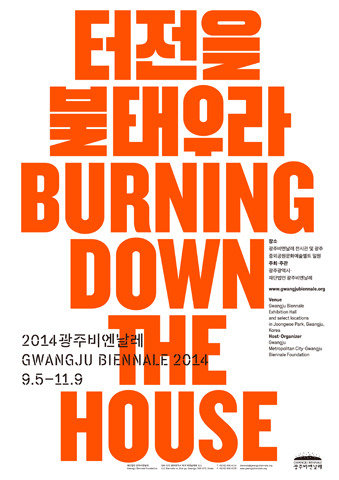10th Gwangju Biennale
dal 4/9/2014 al 8/11/2014
Segnalato da
4/9/2014
10th Gwangju Biennale
Gwangju Biennale, Gwangju
Burning Down the House. The exhibition reflects on the process of transformation, a cycle of obliteration and renewal witnessed throughout history. Often violent, events of destruction or self-destruction, it followed by the promise of the new and the hope for change. With 105 artists from more than 39 countries.

The exhibition is curated by Jessica Morgan, Artistic Director of the Gwangju Biennale and The Daskalopoulos Curator, International Art, Tate Modern. FatosUstek and Emiliano Valdes are Associate Curators for the Biennale, EnnaBae is Associate Curator for Performance and Teresa Kittler is Assistant Curator.
The 10th Gwangju Biennale will bring together 105 artists from more than 39 countries and will include 35 new commissions, each selected for their relevance to the theme of the Biennale, Burning Down the House. Located in the Biennale Halls, the Biennale Square and Joongwoe Park, the exhibition will create an immersive environment of intense experience. The five Halls of the Biennale will be treated as related but thematically differentiated exhibitions, each exploring a different aspect of the title of the biennale. The entrance and exit of each space will be animated or defined by a new commission or existing work that alerts the visitors to the primary experience of art in contrast to the passive realm of digital reception.
Burning Down the Houseexplores the process of burning and transformation, a cycle of obliteration and renewal witnessed throughout history. Evident in aesthetics, historical events, and an increasingly rapid course of redundancy and renewal in commercial culture, the Biennale reflects on this process of, often violent, events of destruction or self-destruction―burning the home one occupies―followed by the promise of the new and the hope for change.
In the 1930s the critic Walter Benjamin coined the term ‘Tigersprung’ (the tiger’s leap) for a new model of history where the past is activated in and through the present within a culture industry that demands constant renewal. What can the ‘Tigerspung’ mean for today’s ‘tiger economies’ like South Korea in a context where economic and political powers deliver the eternally new of fashionable commodities and industrial progress at the apparent expense of a cultural past?
Burning Down the House looks at the spiral of rejection and revitalization that this process implies. The theme highlights the capacity of art to critique the establishment through an exploration that includes the visual, sound, movement and dramatic performance. At the same time, it recognises the possibility and impossibility within art to deal directly and concretely with politics. The energy, the materiality and processes of burning ― the manner in which material is changed and destroyed by flames into the residue of dramatic interventions or remnants of celebrations ― have long informed artistic practice. The transformative powers of fire are central to the way in which this exhibition has been imagined.
Rather than a simple reference to a leftfield pop anthem from the early 1980s, the title reflects the double significance of the proposed Biennale-concept. By fusing physical movement with political engagement, it animates the concept for the decennial of the Gwangju Biennale. When the US-Band Talking Heads were debating the title and chorus of ’Burning Down the House’, their most recognised track, members of the band remembered being at a Funkadelic-concert where George Clinton and the audience swapped calls to ‘Burn Down the House’. This hedonism by the P-Funk crowd on the dance floor was then turned into an anthem of bourgeois anxieties by the New York-based band. This dual meaning of pleasure and engagement serves as the defining spirit of the 10thGwangju Biennale.
Burning Down the Houseexamines the potential of art as movement, by exploring the efforts made by contemporary artists to address personal and public issues through individual and collective engagement, as well as demonstrating how challenging these efforts and their impacts have become. Contrary to museums, with their often hegemonic cultural policies and interest in denoting legacies and traditions, the biennale is a mobile and flexible event, which offers a spectrum of creative expressions that are immediate, contemporary and topical, making the proposed debate of art as movement fitting for the space of Gwangju ― both geopolitically and as an institutional alternative.
Running throughout the duration of the exhibition, both inside the exhibition halls and within specially customized spaces, are new theatrical, dance, and performative commissions by international and Korean artists. Involving more than 400 Gwangju citizens in their realization, these works will provide a constantly changing environment in the exhibition spaces as each day offers a new configuration. During the opening days specially commissioned dance works will take place in the Biennale Halls.
Press contact
Hyeon Kim Fax : +82-(0)62-608-4229 hyeon.kim@gwangjubiennale.org
Opening September 5, 2014 9:00 a.m. to 5:30 p.m.
Biennale Hall, the Biennale Square and Jungoe Park
111 Biennale-ro, yongbong-dong, Buk-gu, Gwangju, 500-845, Republic of Korea
Hours open Everyday 9:00 a.m. to 6:00 p.m.
Ticket Office Hours 8:30 a.m. to 5:30 p.m.



